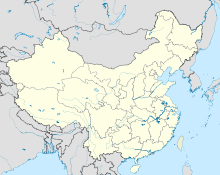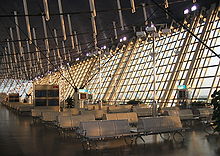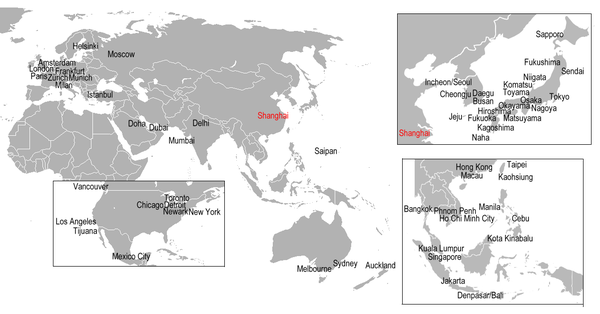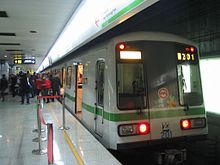- Shanghai Pudong International Airport
-
Shanghai Pudong
International Airport
上海浦东国际机场
Shànghǎi Pǔdōng Guójì Jīchǎng
Logo of Shanghai Airport Authority IATA: PVG – ICAO: ZSPD Summary Airport type Public Operator Shanghai Airport Authority Serves Shanghai Location Pudong New Area Hub for Elevation AMSL 4 m / 13 ft Coordinates 31°08′36″N 121°48′19″E / 31.14333°N 121.80528°ECoordinates: 31°08′36″N 121°48′19″E / 31.14333°N 121.80528°E Website Map Location in China Runways Direction Length Surface m ft 16/34 3,800 12,467 Concrete 17L/35R 4,000 13,123 Concrete 17R/35L 3,400 11,155 Concrete Statistics (2010) Passengers 40,578,621 Cargo (tons) 3,227,914 Source: DAFIF,[2][3] ACI[4] Shanghai Pudong International Airport Traditional Chinese 上海浦東國際機場 Simplified Chinese 上海浦东国际机场 Transcriptions Mandarin - Hanyu Pinyin Shànghǎi Pǔdōng Guójì Jīchǎng - Wade–Giles Shang4hai3 P'u3tung1 Kuo2chi4 Chi1ch'ang3 Cantonese (Yue) - Jyutping Soeng5 hoi2 Pou4 dung1 Gwok3 zai3 gei1 coeng4 - Yale Romanization Shang4 hai1 Pu3 dung1 Gwo2 ji4 Ji1 chang3 Shanghai Pudong International Airport (IATA: PVG, ICAO: ZSPD) (SSE: 600009) (Chinese: 上海浦东国际机场) is the primary international airport serving Shanghai, China, and a major aviation hub in Asia. The other major airport in Shanghai, Hongqiao, mainly serves domestic flights. Located about 30 kilometres (19 mi) east of the city centre, Pudong Airport occupies a 40 square kilometres (15 sq mi) site adjacent to the coastline on the eastern edge of Pudong New Area of Shanghai.
The airport is the main hub for China Eastern Airlines and Shanghai Airlines, and a major international hub for Air China. It is also an Asian-Pacific cargo hub for UPS Airlines.[5] Pudong Airport is organised around two main passenger terminals, flanked on both sides by three parallel runways. Current airport masterplans call for the building of a third passenger terminal, a satellite terminal and two additional runways by 2015, raising its capacity from the current 60 million passengers annually to 80 million, along with the ability to handle six million tonnes of air freight.[6] A station for the Shanghai Maglev Train is sited between the passenger terminals, providing the world's first commercial high-speed maglev service to downtown Pudong in 7 minutes and 20 seconds. The airport is open 24 hours, one of only a few Chinese airports to be so.
Shanghai Pudong International Airport is a fast-growing hub for both passenger and cargo traffic. With 3,227,914 metric tonnes handled in 2010, the airport is the world's third busiest airport by cargo traffic. Pudong Airport also served a total of 40,578,621 passengers in 2010, making it the third busiest airport in mainland China and the 20th busiest in the world. Both passenger and cargo traffic grew by more than 27% in 2010. As China's busiest international airport,[7] about half of Pudong's passenger traffic is international.[8]
Contents
History and development
Early development
Prior to the establishment of Pudong International Airport, Hongqiao International Airport was the primary airport of Shanghai. During the 1990s, the expansion of Hongqiao Airport to meet growing demand became impossible as the surrounding urban area was developing significantly, and an alternative to assume all international flights had to be sought. A suitable site was selected on the coast of the Pudong development zone to the east of Shanghai.
Construction of the first phase of the new Shanghai Pudong International Airport began in October 1997, took two years to build at a cost of RMB 12 billion (1.67 billion USD), and was opened on October 1, 1999. It covers an area of 40 square kilometres (15 sq mi) and is 30 kilometres (19 mi) from downtown Shanghai. The first phase of the airport has one 4E category runway (4000 m x 60 m) along with two parallel taxiways, an 800,000-square-metre (8,600,000 sq ft) apron, seventy-six aircraft positions and a 50,000 m2 (540,000 sq ft) cargo warehouse.
A second runway was opened on March 17, 2005, and construction of phase two (including a second terminal, a third runway and a cargo terminal) began in December 2005 and started operation on March 26, 2008, in time for the Beijing 2008 Summer Olympics. A fourth runway and a third terminal are in the planning stage. The master plan calls for a total of three terminals, two satellite halls, and five parallel runways, with an ultimate capacity of 100 million passengers per year.
Limited international services resumed at Hongqiao Airport in October 2007 with flights to Tokyo International Airport (Haneda), in November 2007 with flights to Gimpo International Airport in Seoul, in June 2010 with flights to Taipei Songshan Airport and in September 2010 with flights to Hong Kong Airport. This is believed to be a major effort to provide convenience to business travelers, a practice already in place between Haneda and Gimpo for years. Hongqiao, Haneda, Gimpo, and Songshan are much closer to their respective metro centers than their newer but remote international gateways Pudong, Narita, Incheon, and Taoyuan.
Expansion
The plan for the next ambitious expansion includes the addition of the fourth and fifth runways, a Satellite concourse, larger than the size of both of the current terminals combined, and additional cargo terminals will expand the size of Pudong International Airport. Land reclamation will be included for the fifth runway and some of the cargo terminals. This next expansion will be completed by 2015 and will make Pudong one of the world's largest airports by land size.
Recently, China Southern Airlines stated that Shanghai Pudong International Airport will be home to its five Airbus A380s, however there is no statement if China Southern Airlines will have a hub in Shanghai Pudong International Airport.
Composition
The airport has 70 boarding bridges along with 218 parking positions. Three runways are in operation: one 4,000-metre (13,000 ft) runway—4E rating—with six taxiways, one 3,800-metre (12,500 ft) runway—4F rating—with four taxiways and one 3,400-metre (11,200 ft) runway—4F rating—with six taxiways.
Terminal 1
Terminal 1 was opened on October 1, 1999 along with a 4000m runway and including a cargo hub. It was built to handle the demand for traffic and to relieve Shanghai Hongqiao International Airport's traffic. Terminal 1 is shaped like Kansai International Airport's terminal, but it is shorter and with 28 gates, 13 of which are double decker gates. The exterior of the terminal is shaped like waves. The capacity of Terminal 1 is 20 million passengers. It currently has 204 check-in counters, thirteen luggage conveying belts and covering an area of 280,000 square meters. Terminal 1 has received some controversy about the lack of shopping stalls, the pricing of the shops, confusing locations of restrooms, the escalators and passenger difficulty of moving through the terminal.
Terminal 2
Terminal 2, opened on 26 March 2008, along with the third runway, gives a capacity of 60 million passengers and 4.2 million tonnes of cargo annually. Terminal 2 is shaped like the 1st terminal but it has more of a seagull shaping, rather than a wave shape and is slightly larger than Terminal 1. Terminal 2 will be used for Air China, Shanghai Airlines and other Star Alliance members but it is known that some SkyTeam and Oneworld members will relocate their operations to the terminal.Terminal 2, located behind Terminal 1, opened on March 26, 2008 (same day as the official opening of Terminal 3 at Beijing Capital International Airport), adding an additional capacity of 40 million passengers a year. Once phase two is fully complete, it will give Pudong a capacity of 60 million passengers and 4.2 million tonnes of cargo annually.[9] A transportation center will be added to connect passengers between Terminal 1 and 2 in the future.
Shanghai Airlines moved to Terminal 2 upon its opening on March 26, 2008 with 14 other airlines, including Air India, Northwest Airlines, Qatar Airways, Alitalia, British Airways, Qantas, Virgin Atlantic Airways, Philippine Airlines, Malaysia Airlines, Transaero Airlines, Cebu Pacific, Aerosvit Airlines, Garuda Indonesia and Royal Nepal Airlines. Fellow Star Alliance partners Air Canada, Air China, Air New Zealand, ANA, Asiana Airlines, Lufthansa, Singapore Airlines, Thai Airways and United Airlines have moved on April 29, 2008[10] along with other airlines, involving 33 airlines in all now operating at Terminal 2.[9]
Airlines and destinations
Airlines Destinations Terminal Aeroflot Moscow-Sheremetyevo 2 Aeroméxico Mexico City, San José del Cabo [ends 7 January], Tijuana [resumes 12 January] 2 Air Canada Toronto-Pearson, Vancouver 2 Air China Beijing-Capital, Chengdu, Chongqing, Frankfurt, Fukuoka, Guilin, Guiyang, Jiuzhaigou, Melbourne, Milan-Malpensa, Nagoya-Centrair, Osaka-Kansai, Paris-Charles de Gaulle [resumes 10 March 2012], Qingdao, Sendai, Shenzhen, Sydney, Taipei-Taoyuan, Tokyo-Narita, Wenzhou, Xi'an, Yichang, Yinchuan 2 Air France Paris-Charles de Gaulle 1 Air India Delhi, Mumbai 2 Air Koryo Seasonal: Pyongyang 2 Air Macau Macau 2 Air Mauritius MauritiusNote 1 2 Air New Zealand Auckland 2 Airphil Express Kalibo 2 All Nippon Airways Osaka-Kansai, Tokyo-Narita
Seasonal: Nagoya-Centrair2 American Airlines Chicago-O'Hare, Los Angeles 2 Asiana Airlines Busan, Seoul-Incheon 2 British Airways London-Heathrow 2 Cathay Pacific Hong Kong 2 Cebu Pacific Manila 2 China Airlines Kaohsiung, Taipei-Taoyuan 1 China Eastern Airlines Bangkok-Suvarnabhumi, Beihai, Beijing-Capital, Busan, Changchun, Chengdu, Chifeng, Chongqing, Daegu, Dalian, Delhi, Denpasar/Bali, Dubai, Frankfurt, Fukuoka, Fukushima, Fuzhou, Guangzhou, Guilin, Haikou, Hamburg, Hanoi, Harbin, Hiroshima, Ho Chi Minh City, Hong Kong, Honolulu, Huai'an, Jeju, Jiayuguan, Kagoshima, Komatsu, Kuala Lumpur, Kunming, Lhasa, London-Heathrow, Los Angeles, Matsuyama, Melbourne, Moscow-Sheremetyevo, Nagasaki, Nagoya-Centrair, Naha, Nanchang, Nanjing, New York-JFK, Niigata, Ningbo, Okayama, Osaka-Kansai, Paris-Charles de Gaulle, Qingdao, Rome-Fiumicino, Saipan, Sanya, Sapporo-Chitose, Seoul-Incheon, Shenyang, Shenzhen, Siem Reap, Singapore, Sydney, Taipei-Taoyuan, Tokyo-Narita, Vancouver, Wenzhou, Wuhan, Xi'an, Xining, Yan'an, Yancheng, Yichang, Yinchuan, Yulin, Zhangjiajie, Zhengzhou, Zhoushan, Zhuhai 1 China Southern Airlines Changbaishan, Changchun, Changsha, Dalian, Dandong, Daqing, Guangzhou, Haikou, Harbin, Jiamusi, Kunming, Mudanjiang, Nagoya-Centrair, Nanning, Qiqihar, Sanya, Seoul-Incheon, Shantou, Shenyang, Shenzhen, Taipei-Taoyuan, Wuhan, Xi'an, Zhangjiajie, Zhengzhou, Zhuhai 2 Chongqing Airlines Chongqing 2 Continental Airlines Newark 2 Delta Air Lines Atlanta, Detroit, Tokyo-Narita 2 Dragonair Hong Kong 2 Emirates Dubai 2 Etihad Airways Abu Dhabi [begins 2 March 2012][11] 2 EVA Air Kaohsiung, Taipei-Taoyuan 2 Finnair Helsinki 2 Garuda Indonesia Denpasar/Bali, Jakarta-Soekarno-Hatta 2 Grand China Express Dongying, Weifang 1 Hainan Airlines Brussels [ends 1 January], Haikou, Istanbul-Ataturk [ends 1 December], Lanzhou, Shenzhen, Urumqi [ends 1 December], Xi'an 1 Hong Kong Airlines Hong Kong 2 Hong Kong Express Airways Hong Kong 2 Japan Airlines Nagoya-Centrair, Osaka-Kansai, Tokyo-Narita 1 Japan Airlines operated by JAL Express Osaka-Kansai 1 Jin Air Jeju 2 Juneyao Airlines Baotou, Beihai, Changchun, Dalian, Fuzhou, Guilin, Harbin, Hong Kong, Macau, Manzhouli, Nanchang, Sanya, Shenyang, Shijazhuang, Tongliao, Wenzhou, Xiamen, Yichang, Zhuhai
Seasonal: Hailar1 KLM Amsterdam 1 Korean Air Busan, Seoul-Incheon 1 Lufthansa Frankfurt, Munich 2 Mahan Air Tehran-Imam Khomeini 2 Malaysia Airlines Kuala Lumpur 2 Mega Maldives Malé 2 Philippine Airlines Manila 2 Qantas Sydney 2 Qatar Airways Doha 2 Royal Brunei Airlines Bandar Seri Begawan 1 Scandinavian Airlines Copenhagen [resumes 2 March 2012][12][13] 2 Shandong Airlines Qingdao 2 Shanghai Airlines Anqing, Bangkok-Suvarnabhumi, Busan, Changchun, Changsha, Chengdu, Chongqing, Da Nang, Dalian, Denpasar/Bali, Haikou, Harbin, Hong Kong, Jiayuguan, Jinzhou, Macau, Male, Mudanjiang, Osaka-Kansai, Phnom Penh, Phuket, Qinhuangdao, Qingdao, Sanya, Seoul-Incheon, Shenyang, Taipei-Songshan, Tangshan, Toyama, Wanzhou, Weihai, Wuhan, Xi'an, Xiangyang, Yantai, Zhangjiajie 2 Shenzhen Airlines Jinjiang/Quanzhou, Nanchang 1 Sichuan Airlines Chengdu, Chongqing
Charter: Saipan1 Singapore Airlines Singapore 2 Spring Airlines Changchun, Chongqing, Dalian, Harbin, Hong Kong, Ibaraki, Macau, Nanning, Shenyang, Takamatsu, Xi'an, Xiamen, Zhangjiajie
Seasonal: Guilin, Haikou, Sanya1 SriLankan Airlines Bangkok-Suvarnabhumi, Colombo 1 Swiss International Air Lines Zürich 2 Thai Airways International Bangkok-Suvarnabhumi 2 Transasia Airways Taichung, Taipei-Songshan, Taipei-Taoyuan 2 Turkish Airlines Istanbul-Atatürk 2 United Airlines Chicago-O'Hare, Los Angeles, San Francisco 2 Vietnam Airlines Hanoi, Ho Chi Minh City 2 Virgin Atlantic Airways London-Heathrow 2 Xiamen Airlines Fuzhou, Quanzhou/Jinjiang, Wuyishan, Xiamen 1 Zest Airways Cebu, Kalibo 1 Notes:
- ^Note 1 : Air Mauritius's flight from Shanghai to Mauritius has a stopover in Kuala Lumpur. However, Air Mauritius has no rights to transport passengers solely between Shanghai and Kuala Lumpur.
Cargo airlines
Airlines Destinations Aeroflot-Cargo Novosibirsk Air Cargo Germany Frankfurt-Hahn Air China Cargo Beijing-Capital, Copenhagen, Los Angeles, Milan-Malpensa, Manchester, Paris-Charles de Gaulle, Portland (OR), Vienna Air France Paris-Charles de Gaulle Air Hong Kong Hong Kong AirBridgeCargo Airlines Krasnoyarsk ANA & JP Express Atlas Air Chicago-O'Hare, Frankfurt, Honolulu, Melbourne, New York-JFK, Sydney Cargolux Luxembourg Cargo Garuda Indonesia Jakarta-Soekarno-Hatta Cathay Pacific Cargo Hong Kong China Airlines Cargo Taipei-Taoyuan China Cargo Airlines Amsterdam, Anchorage, Atlanta, Bangkok-Suvarnabhumi, Beijing-Capital, Chicago-O'Hare, Chongqing, Copenhagen, Dallas/Fort Worth, Dhaka, Hong Kong, Los Angeles, Luxembourg, Milan-Malpensa, Osaka-Kansai, Paris-Charles de Gaulle, Seoul-Incheon, Shenzhen, Singapore, St.Louis [14], Taipei-Taoyuan, Tianjin, Tokyo-Narita, Xiamen[15] China Southern Cargo Amsterdam, Chicago-O'Hare, Frankfurt, Los Angeles, Vancouver,[16] Vienna Emirates SkyCargo Almaty, Dubai Etihad Crystal Cargo Abu Dhabi, Chennai EVA Air Cargo Taipei-Taoyuan FedEx Express Anchorage, Beijing-Capital, Guangzhou, Memphis Finnair Cargo operated by World Airways Helsinki Great Wall Airlines Amsterdam, Manchester Jade Cargo International Amsterdam, Anchorage, Chennai, Chicago, Dubai, Frankfurt, Barcelona, Geneva, Istanbul-Ataturk, Kaunas, Milan-Malpensa, Mumbai, Shenzhen Lufthansa Cargo Frankfurt Martinair Cargo / KLM Cargo Amsterdam, Moscow-Sheremetyevo MASkargo Amsterdam, Basel/Mulhouse, Kuala Lumpur, Penang, Tashkent MNG Airlines Istanbul-Ataturk Nippon Cargo Airlines Osaka-Kansai, Tokyo-Narita Polar Air Cargo Osaka-Kansai SAS Cargo Group Beijing-Capital, Copenhagen Saudi Arabian Airlines Cargo Bangkok-Suvarnabhumi, Jeddah, Riyadh Shanghai Airlines Cargo Singapore Airlines Cargo Los Angeles, Singapore Silk Way Airlines Baku Turkish Airlines Cargo Istanbul-Atatürk TNT Airways Liège, Singapore UPS Airlines Almaty, Anchorage, Chengdu, Cologne/Bonn, Osaka-Kansai, Seoul-Incheon, Shenzhen, Tokyo-Narita, Warsaw Volga-Dnepr Abakan Yanda Airlines Bangkok-Suvarnabhumi Yangtze River Express Anchorage, Bangkok-Suvarnabhumi, Chicago-O'Hare Ground transportation
Transrapid constructed the first commercial high-speed maglev railway in the world, from the Pudong International Airport to Longyang Road Metro station. It was inaugurated in 2002. It has a peak speed of 431 km/h and a track length of 30 km. A transportation center will be built in Phase 3, and will become operational in 2015. The extension of the Shanghai Metro Line 2 to Pudong International Airport has been completed. Pudong International Airport and Shanghai Hongqiao Airport are linked by subway.
Incidents and accidents
- On January 30, 2006, the nose gear of a Cargolux Boeing 747-400F collapsed while parked on the cargo apron.[17]
- On May 13, 2006, A China Eastern Airbus A340-600 (Tail number B6055), flight 5042 from Seoul to Shanghai suffered tire bursts on all of its main landing gears. None of the 232 passengers were hurt.[18]
- On November 19, 2006, An Air Canada Boeing 767-300 flight 38 encountered severe turbulence en route to Vancouver from Shanghai. Four cabin members were hurt. The plane safely landed in Tokyo's Narita International Airport. This incident occurred just after a domestic Japan Airlines Boeing 777 flight 1348 experienced turbulence which landed safely in Tokyo's Haneda Airport[citation needed].
- On the morning of November 28, 2009, An Avient McDonnell Douglas MD-11F cargo plane registered to Zimbabwe (Reg: Z-BAV) departing for Kyrgyzstan crashed into a warehouse near the runway of the airport due to a tailstrike that caught fire during takeoff and broke into several pieces with seven people on board. Three people died and four were injured.[19][20][21]
Photo gallery
-
Air New Zealand Boeing 777 at the airport
-
Air China Airbus A340 about to take off from Pudong
See also
- Shanghai Hongqiao International Airport
- List of airports in the People's Republic of China
- List of the busiest airports in the People's Republic of China
References
- ^ http://www.pressroom.ups.com/Fact+Sheets/UPS+Air+Operations+Facts
- ^ Airport information for ZSPD at World Aero Data. Data current as of October 2006.Source: DAFIF.
- ^ Airport information for PVG at Great Circle Mapper. Source: DAFIF (effective Oct. 2006).
- ^ Passenger Traffic 2010 FINAL
- ^ UPS Air Operations Facts
- ^ Shanghai Airport reports profit growth, despite big investments in massive new facilities at Pudong – China Airlines, Airports and Aviation News. Chinaaviation.aero (2008-03-11). Retrieved on 2011-01-22.
- ^ "Top international routes in China and India. Shanghai Pudong and Delhi dominate". CAPA. September 13, 2011. http://www.centreforaviation.com/analysis/top-international-routes-in-china-and-india-shanghai-pudong-and-mumbai-dominate-58671.
- ^ "From obscurity, Guangzhou and Shanghai Pudong airports move up rankings". CAPA. June 3, 2011. http://www.centreforaviation.com/news/2011/06/03/from-obscurity-guangzhou-and-shanghai-pudong-airports-move-up-rankings/page1.
- ^ a b Dermot Davitt Shanghai Pudong International Airport begins new era with opening of Terminal Two 26/03/08, Source: The Moodie Report
- ^ Travel News Your Way. e-Travel Blackboard. Retrieved on 2011-01-22.
- ^ http://www.etihadairways.com/sites/Etihad/cn/en/aboutetihad/mediacenter/newslisting/newsdetails/Pages/new-shanghai-service-continues-etihad-china-expansion-Jul11.aspx?fromNewsListing=true
- ^ "Airline Routes". Air Transport World. 9 June 2011. http://atwonline.com/airports-routes/news/airline-routes-0608. Retrieved 29 June 2011. "Scandinavian Airlines will relaunch five-times-weekly Airbus A340-300 Copenhagen-Shanghai Pudong service March 1, 2012."
- ^ "SAS launches Copenhagen-Shanghai in March 2012" (Press release). SAS Group. 8 June 2011. http://se.yhp.waymaker.net/sasgroup/release.asp?id=228213. Retrieved 29 June 2011.
- ^ http://www.stltoday.com/business/local/article_dfdce377-a2ba-58a0-a673-e30f140caf29.html
- ^ [1]
- ^ [2]
- ^ Photos: Boeing 747-4R7F/SCD Aircraft Pictures. Airliners.net. Retrieved on 2011-01-22.
- ^ Photos: Airbus A340-642 Aircraft Pictures. Airliners.net. Retrieved on 2011-01-22.
- ^ Cargo plane crashes at Shanghai airport – Xinhua. Reuters. Retrieved on 2011-01-22.
- ^ 浦东机场货机坠毁现场浓烟滚滚(组图)_新浪航空航天_新浪网. Mil.news.sina.com.cn. Retrieved on 2011-01-22.
- ^ Report: Three dead in cargo plane crash in Shanghai | CNN.com
External links
- Shanghai Airport, official website (English)
- Airliners.Net photos of Shanghai Pudong International Airport
- Current weather for ZSPD at NOAA/NWS
- Accident history for PVG at Aviation Safety Network
Municipality of Shanghai Administrative divisions County Areas Culture and demographics Attractions Jinjiang Action Park • Nanjing Road • Shanghai Concert Hall • Shanghai Grand Theatre • Shanghai New International Expo Center • Shanghai Zoo • Yuyuan GardenMuseums Parks Places of Worship ChristianOtherSports venues Towers Transport Hongqiao International Airport • Pudong International Airport • Shanghai Metro • Shanghai Public Transportation Card • Maglev Train • Shanghai Railway Station • Shanghai South Railway Station • Hongqiao Railway Station • Trams in Shanghai • Zhangjiang Tram • Shanghai Bus • Trolleybuses in ShanghaiUniversities Major hotels Transport in the People's Republic of China Government agencies Road Expressways (NTHS) · China National Highways · Road numbering · Rules (Road safety law) · Licence plates · AH1 · Gallery road · Zhongshan Road · Automobile industry · Motor Vehicle Driving LicenseRail History (Eastern-Qing · South Manchuria · Narrow-gauge) · Passenger rail · China Railways · High-speed (Wuhan-Guangzhou · Beijing-Tianjin · Qinhuangdao-Shenyang · Guangzhou-Shenzhen) · Lines (Beijing-Harbin · Beijing-Shanghai · Beijing-Hong Kong · Beijing-Guangzhou · Lanzhou-Lianyungang · Lanzhou-Xinjiang · Qinghai-Tibet) · Locomotives · Stations · Rapid transit systems · MaglevWater CanalsShipping industry · China Shipbuilding Industry Corporation · China State Shipbuilding Corporation · Ship liftsAviation By passenger traffic · By cargo traffic · By traffic movements · Major Airports: Beijing Capital · Guangzhou Baiyun · Hong Kong* · Macau* · Shanghai Hongqiao · Shanghai PudongOther topics  Category · Economy · Communications
Category · Economy · Communications
* in / related to the special administrative regionsCategories:- Companies listed on the Shanghai Stock Exchange
- Airports in Shanghai
- Government-owned companies in the People's Republic of China
- Airports established in 1999
Wikimedia Foundation. 2010.










